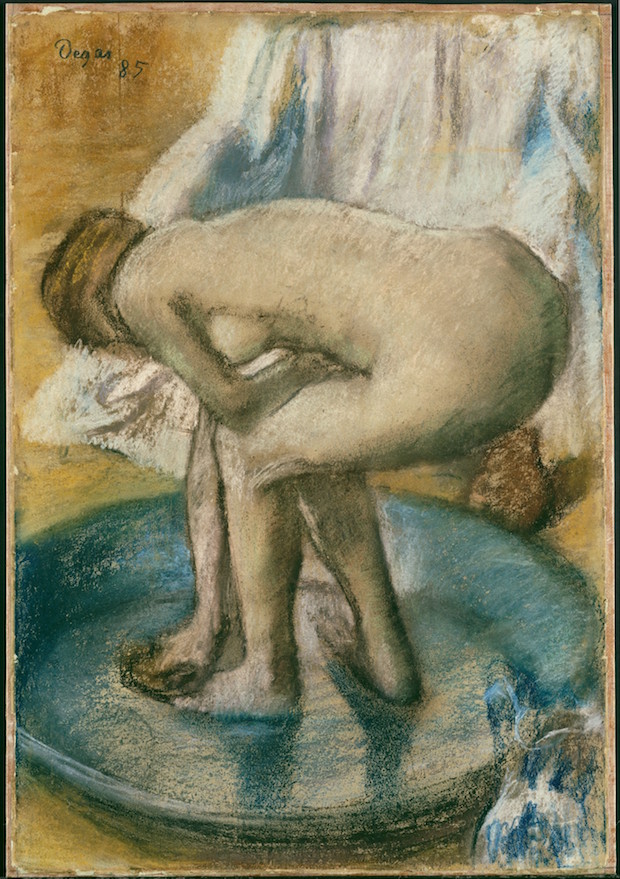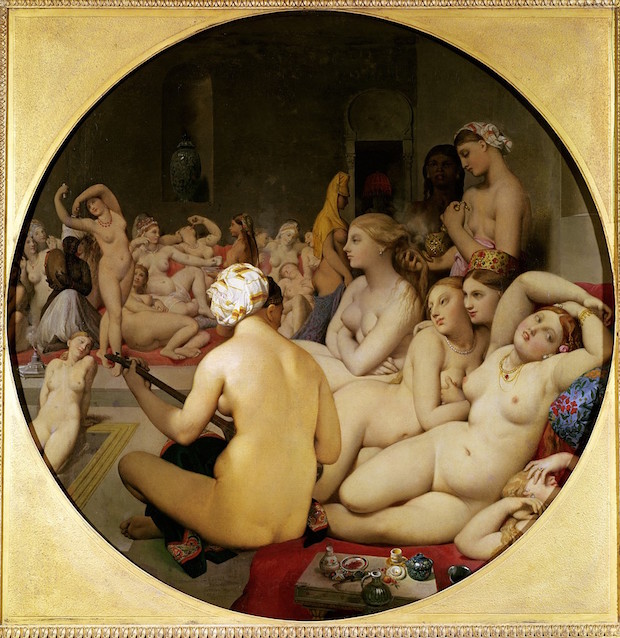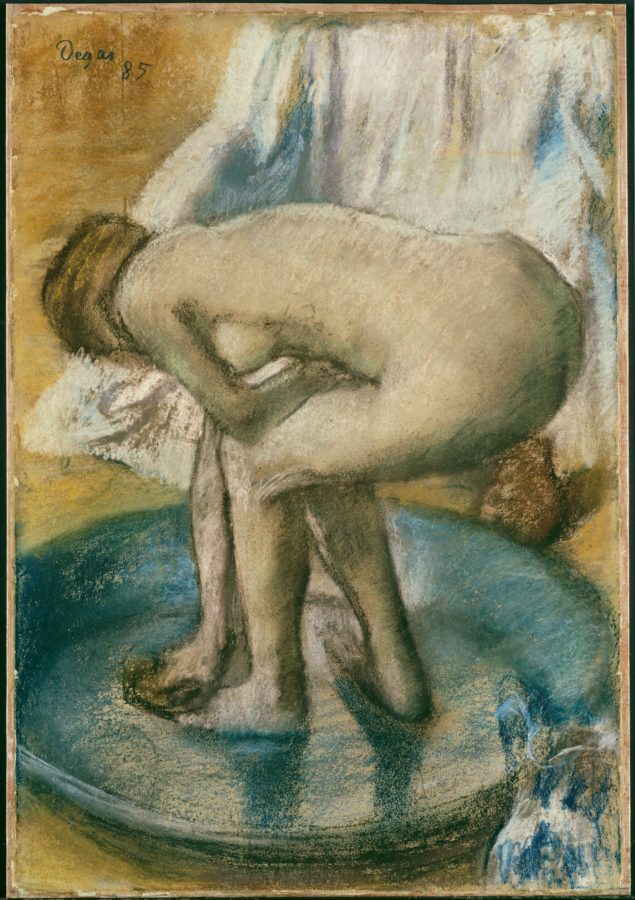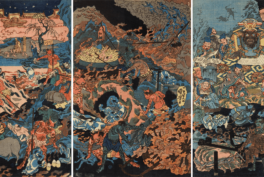Even before rubber ducks were invented, people had loved bathing. And they loved to peep at others bathe. Nothing’s changed, soap operas are still in fashion 😉
1. Paul Cezanne, The Large Bathers

[easyazon_link identifier=”0307377075″ locale=”US” tag=”dailyartdaily-20″]Cezanne[/easyazon_link] worked on this painting for 7 years and still it remained unfinished until his death. It’s a revised version of several other canvases on the same topic, considered Cezanne’s finest work and one of the world’s masterpieces. Cezanne strove to create a timeless atmosphere, some kind of monumentality which could appeal to all generations throughout times. The naked figures are framed in a triangle formed by the trees and the river, a composition which makes the work reminiscent of the great masters like [easyazon_link identifier=”006059876X” locale=”US” tag=”dailyartdaily-20″]Titian[/easyazon_link] or [easyazon_link identifier=”190753377X” locale=”US” tag=”dailyartdaily-20″]Rubens[/easyazon_link].
Find more:
[easyazon_image align=”none” height=”160″ identifier=”0307377075″ locale=”US” src=”https://www.dailyartmagazine.com/wp-content/uploads/2016/07/614GcE7BFeL.SL160-2.jpg” tag=”dailyartdaily-20″ width=”122″] [easyazon_image align=”none” height=”160″ identifier=”1606064649″ locale=”US” src=”https://www.dailyartmagazine.com/wp-content/uploads/2016/07/51lGlC1kI9L.SL160.jpg” tag=”dailyartdaily-20″ width=”106″] [easyazon_image align=”none” height=”160″ identifier=”3822856428″ locale=”US” src=”https://www.dailyartmagazine.com/wp-content/uploads/2016/07/61yX7ukkvL.SL160-1.jpg” tag=”dailyartdaily-20″ width=”129″]
2. Edgar Degas, Woman bathing in a shallow tub

The pastel studies of the nude are perhaps the most important part of [easyazon_link identifier=”3775734430″ locale=”US” tag=”dailyartdaily-20″]Degas[/easyazon_link]’ ouevre, as he used them to introduce and practice new ideas and techniques. He loved pastel for its spontaneity, as it didn’t need time to dry, so he could rework the images multiple times. He mostly depicted women in private yet without a voyeuristic approach. His models are always relaxed, focused on their bodies and enjoying the baths.
Find more:
[easyazon_image align=”none” height=”160″ identifier=”3775734430″ locale=”US” src=”https://www.dailyartmagazine.com/wp-content/uploads/2016/07/61eaA0z5FoL.SL160-1.jpg” tag=”dailyartdaily-20″ width=”129″] [easyazon_image align=”none” height=”160″ identifier=”B00VQUXNY8″ locale=”US” src=”https://www.dailyartmagazine.com/wp-content/uploads/2016/07/41CjfhtkVuL.SL160.jpg” tag=”dailyartdaily-20″ width=”141″] [easyazon_image align=”none” height=”160″ identifier=”1606063278″ locale=”US” src=”https://www.dailyartmagazine.com/wp-content/uploads/2016/07/51MsPdHyAdL.SL160.jpg” tag=”dailyartdaily-20″ width=”107″]
3. Jean-Auguste-Dominique Ingres, The Turkish Bath

[easyazon_link identifier=”0714848689″ locale=”US” tag=”dailyartdaily-20″]Ingres[/easyazon_link] made this erotic tondo painting when he was 82 years old but he said he still ‘retained all the fire of a man of thirty years’. Yet, he didn’t paint it from live models as he relied mostly on his previous paintings of the same subject. It seems to be based on an 18th cent. description of a harem in which the author stated that she had seen two hundred nude women at a time. This harem does definitely look crammed.
Find more:
[easyazon_image align=”none” height=”160″ identifier=”3848005565″ locale=”US” src=”https://www.dailyartmagazine.com/wp-content/uploads/2016/07/51wNz9GH88L.SL160.jpg” tag=”dailyartdaily-20″ width=”137″] [easyazon_image align=”none” height=”160″ identifier=”0714848689″ locale=”US” src=”https://www.dailyartmagazine.com/wp-content/uploads/2016/07/41vJGphCG3L.SL160.jpg” tag=”dailyartdaily-20″ width=”138″] [easyazon_image align=”none” height=”160″ identifier=”0789200600″ locale=”US” src=”https://www.dailyartmagazine.com/wp-content/uploads/2016/07/51l92Bsog4eL.SL160.jpg” tag=”dailyartdaily-20″ width=”138″]
4. Jean Leon Jerome, The Turkish Bath, 1885

[easyazon_link identifier=”8857207021″ locale=”US” tag=”dailyartdaily-20″]Gerome[/easyazon_link] was a master of a trendy 19th century style called [easyazon_link identifier=”039474067X” locale=”US” tag=”dailyartdaily-20″]Orientalism[/easyazon_link], which would depict with a photograpic realism the world that existed only in the common Western imagination – the Orient. Jerome loved to paint young white naked ladies in the bath. Moreover, they usually had black and fully clad servants whose only duty was to wash them and, composition-wise, emphasize their pure whiteness. Sadly, according to the orientalising Westerners of that time, white skin meant superiority, grace and innocence whereas any other skin tone meant all the contrary.
Find more:
[easyazon_image align=”none” height=”160″ identifier=”039474067X” locale=”US” src=”https://www.dailyartmagazine.com/wp-content/uploads/2016/07/51k6n6maNL.SL160.jpg” tag=”dailyartdaily-20″ width=”104″] [easyazon_image align=”none” height=”160″ identifier=”0789204592″ locale=”US” src=”https://www.dailyartmagazine.com/wp-content/uploads/2016/07/51wQbMuzJ3L.SL160.jpg” tag=”dailyartdaily-20″ width=”137″] [easyazon_image align=”none” height=”160″ identifier=”3895088927″ locale=”US” src=”https://www.dailyartmagazine.com/wp-content/uploads/2016/07/510F91AWJTL.SL160.jpg” tag=”dailyartdaily-20″ width=”137″]
5. Florentijn Hofman, Floating Rubber Duck
The Dutch artist [easyazon_link identifier=”B01BU84Y4I” locale=”US” tag=”dailyartdaily-20″]Florentijn Hofman[/easyazon_link] has been making Rubber Duck sculptures since 2007. He’s exhibited them all around the world, e.g. Japan, the States, the Netherlands, Brasil, Australia… He believes that his sculptures can unite people and make them happier. I think that a giant rubber duck, in the bath or anywhere else in the world, can make everyone happy.
Find more:
[easyazon_image align=”none” height=”133″ identifier=”B01BU895L0″ locale=”US” src=”https://www.dailyartmagazine.com/wp-content/uploads/2016/07/51PU3jszfL.SL160.jpg” tag=”dailyartdaily-20″ width=”160″] [easyazon_image align=”none” height=”112″ identifier=”B01BU84Y4I” locale=”US” src=”https://www.dailyartmagazine.com/wp-content/uploads/2016/07/513LVk2zQLL.SL160.jpg” tag=”dailyartdaily-20″ width=”160″]




